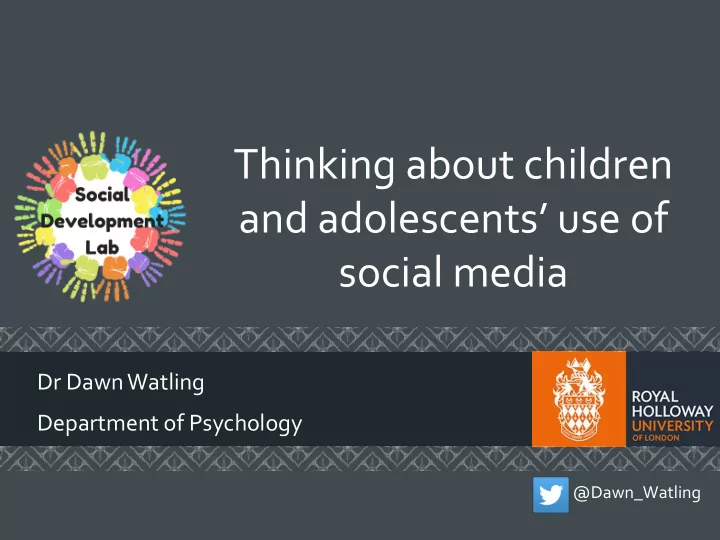

Thinking about children and adolescents’ use of social media Dr Dawn Watling Department of Psychology @Dawn_Watling
8 Feb, 2018 9 th Feb, 2016 Who is online? 53% 3-4 year olds 79% 5-7 year olds 94% 8-11 year olds 99% 12-15 year olds (Ofcom, 2017)
Social media use Who has a social media profile? ••23% of 8- to 11-year-old ••75% of 12- to 15-year-olds ••90% of 16- to 14-year-olds What are they using? ••74% use Facebook ••58% use Snapchat ••57% use Instagram (Ofcom, 2017; Pew Research Centre, 2017)
13% of 12-15 year olds “agree that getting likes or followers is more important to them than keeping their posts, comments or photos private … [and that] there is pressure to look popular on social media ‘all the time’.” (Ofcom, 2017)
Are there benefits of social media use? Create (& manage) Wider social impressions network ••Identity exploration ••Access to friend groups ••Greater perceived support Wider support network ••Greater access to support and support lines (Best et al., 2014)
What are the risks of social media use? Exposure to harm Social isolation ••Befriending strangers ••Low self-esteem ••Grooming ••Depression Cyberbullying & cyberstalking ••Typically those bullied online are also bullied in the school grounds (Best et al., 2014; Davis, 2012; Hundley & Shyles, 2010)
What enhances of likelihood of experiencing the risks? • Time spent online • Passive, rather than active, use of SNS sites (Best et al., 2014; Burke et al., 2010; Ofcom, 2017)
My focus Managing impressions Impression management Differential social media use through social media for those with social anxiety Children’s online self-disclosure Understanding the benefits Cyberbullying and and risks of social media cyberstalking Benefits & risks
My focus: Managing impressions • Identity exploration and impression management… Present real, ideal, or fake self (Michikyan et al., 2014) • Sharing information online: Adults (M Participants high in FNE = 23 years) higher in fear of negative (left) looking more at shares than participants evaluation use social cues for deciding low in FNE (right) in about presenting information (Poon & High Share condition Watling, 2017) • Upcoming projects: • Instagram filters
My focus: Social media Benefits & Risks • Children’s understanding of the benefits and risks • Adolescents don’t see risky behaviour as ‘risky’ • Parents aren’t always aware of children’s activities online • Cyberbullying & cyberstalking from an interdisciplinary perspective • 45% of 12-15 year olds report they have seen hateful content directed at groups of individuals; 60% say they ignored it (Ofcom, 2017) • Younger children are more likely to report than older children
Cyberbullying and cyberstalking H ub for research into I ntergenerational Project Launch V ulnerability to E xploitation Protecting adolescents from cyberbullying and cyberstalking 11 th June 12-4pm, Senate House, London @HiveRhul
Summary and implications Children under 13 are aware of and using social media There are benefits to social media use (e.g., allows people to ‘experiment’ with possible selves) There are risks to social media use (many are related to time spend online) Need to work together to establish effective programmes to support online safety (including changing social norms)
Workshop this afternoon… Online safety: Promoting children and adolescents’ safe social media use
Thank you for listening. Please contact me with any questions or if you would like to get involved in any of our work! Dawn.Watling@rhul.ac.uk Find out more about our research: Social Development Lab: www.pc.rhul.ac.uk/sites/social_development/ HIVE: www.pc.rhul.ac.uk/sites/hive/ @Dawn_Watling @SocDevLabRHUL @HiveRhul
References Best, P., Manktelow, R., & Taylor, B (2014). Online communication, social media and adolescent wellbeing: A systematic narrative review. Children and Youth Services Review, 41, 27–36. Burke, M., Marlow, C., & Lento, T. (2010). Social network activity and social well-being. Postgraduate Medical Journal, 85 , 455-459 Davis, K. (2012). Friendship 2.0: Adolescents' experiences of belonging and self-disclosure online. Journal of Adolescence, 35 , 1527-1536. Hundley, H. L., & Shyles, L. (2010). US Teenagers’ Perceptions and Awareness of Digital Technology: A Focus Group Approach . New Media & Society. Michikyan, M., Dennis, J., & Subrahmanyam, K. (2015). Can you guess who I am? Real, ideal, and false self-presentation on Facebook among emerging adults. Emerging Adulthood, 3, 55- 64. Ofcom (29 November, 2017). Children and parents: Media use and attitudes report. Retrieved on 29/01/2018 from https://www.ofcom.org.uk/__data/assets/pdf_file/0020/108182/children- parents-media-useattitudes-2017.pdf
Recommend
More recommend